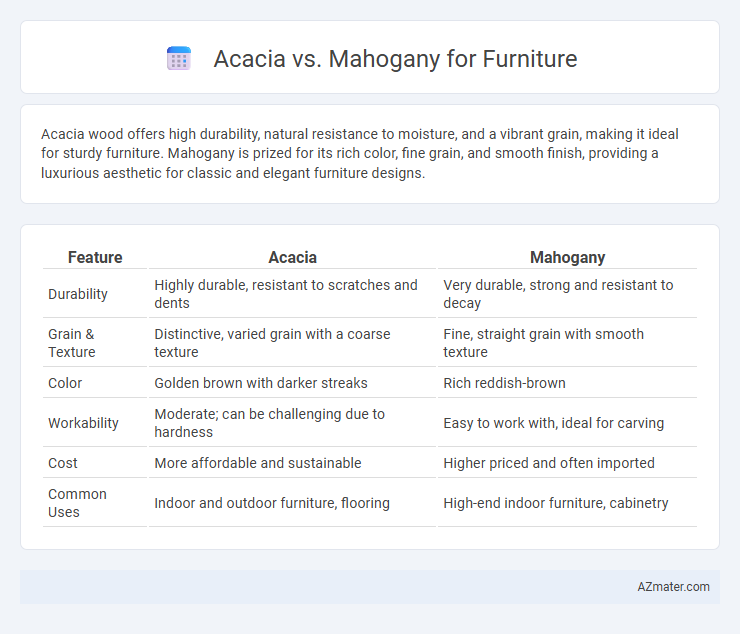Acacia wood offers high durability, natural resistance to moisture, and a vibrant grain, making it ideal for sturdy furniture. Mahogany is prized for its rich color, fine grain, and smooth finish, providing a luxurious aesthetic for classic and elegant furniture designs.
Table of Comparison
| Feature | Acacia | Mahogany |
|---|---|---|
| Durability | Highly durable, resistant to scratches and dents | Very durable, strong and resistant to decay |
| Grain & Texture | Distinctive, varied grain with a coarse texture | Fine, straight grain with smooth texture |
| Color | Golden brown with darker streaks | Rich reddish-brown |
| Workability | Moderate; can be challenging due to hardness | Easy to work with, ideal for carving |
| Cost | More affordable and sustainable | Higher priced and often imported |
| Common Uses | Indoor and outdoor furniture, flooring | High-end indoor furniture, cabinetry |
Introduction: Acacia and Mahogany in Furniture Making
Acacia and Mahogany are two popular hardwoods widely used in furniture making due to their durability and aesthetic appeal. Acacia wood is valued for its natural resistance to moisture and striking grain patterns, making it ideal for both indoor and outdoor furniture. Mahogany offers a rich, reddish-brown hue and exceptional strength, often favored for high-end, classic furniture pieces.
Wood Origin and Sustainability
Acacia wood originates primarily from Australia and Africa, known for its durability and fast growth, making it a more sustainable option compared to mahogany, which is typically sourced from tropical rainforests in Central and South America. Mahogany, prized for its rich color and fine grain, faces sustainability challenges due to overharvesting and slower growth rates. Choosing acacia for furniture supports responsible forestry practices and reduces environmental impact.
Appearance and Color Variations
Acacia wood features a rich, warm tone with golden to reddish-brown hues and distinctive grain patterns that create a natural, rustic appearance ideal for casual and modern furniture styles. Mahogany offers a deep reddish-brown color that darkens over time, showcasing a smooth, fine grain with a luxurious, classic appeal favored in traditional and high-end furniture designs. The color variations in Acacia tend to be more pronounced and varied, while Mahogany maintains a consistent, elegant richness that enhances the sophistication of crafted pieces.
Durability and Hardness Comparison
Acacia wood is known for its exceptional durability and resistance to wear, ranking around 1,700 on the Janka hardness scale, making it harder than many hardwoods. Mahogany, while prized for its rich color and smooth grain, has a lower Janka hardness rating of approximately 800 to 900, indicating moderate hardness and less resistance to dents and scratches. Choosing Acacia for furniture ensures enhanced longevity and toughness, especially in high-traffic or heavy-use areas, whereas Mahogany offers aesthetic appeal with moderate durability.
Workability for Craftsmen
Acacia wood offers excellent workability for craftsmen due to its moderate density and fine, even grain, allowing smooth cutting, sanding, and finishing without excessive wear on tools. Mahogany, prized for its softness relative to other hardwoods, facilitates effortless carving, shaping, and intricate detailing, making it a favorite in fine furniture craftsmanship. While Acacia provides durability with moderate workability, Mahogany ensures easier manipulation, both essential considerations for skilled artisans in custom furniture production.
Maintenance and Longevity
Acacia wood offers excellent durability and resistance to scratches and moisture, requiring only regular dusting and occasional oiling to maintain its natural luster. Mahogany, known for its rich color and fine grain, demands more careful maintenance including controlled humidity and periodic polishing to prevent drying and cracking. Both woods provide long-lasting furniture, with Acacia generally favored for outdoor use due to its superior weather resistance, while Mahogany excels in indoor settings where preservation of aesthetic appeal is prioritized.
Cost and Market Value
Acacia furniture typically offers a more affordable price point compared to mahogany, making it a popular choice for budget-conscious buyers. Mahogany is valued higher in the market due to its rich grain, durability, and status as a premium hardwood, often commanding elevated prices. The market value of mahogany furniture remains strong in luxury segments, while acacia serves well for versatile, cost-effective pieces.
Environmental Impact
Acacia furniture is often regarded as more environmentally sustainable due to its fast growth rate and ability to regenerate quickly compared to mahogany, which typically grows slower and is frequently harvested from endangered hardwood forests. Acacia wood harvesting practices usually have a lower carbon footprint and contribute less to deforestation, while mahogany sourcing can drive illegal logging and habitat loss. Choosing acacia helps promote responsible forestry management and supports eco-friendly furniture production.
Best Uses in Furniture Types
Acacia wood is best suited for outdoor furniture and rustic-style pieces due to its high durability, natural resistance to moisture, and attractive grain patterns. Mahogany excels in fine indoor furniture such as cabinets, tables, and chairs, prized for its smooth texture, rich reddish-brown color, and excellent workability. Both woods offer unique strengths: Acacia for robust, weather-resistant applications, and Mahogany for elegant, polished interiors.
Choosing the Right Wood for Your Needs
Acacia wood offers exceptional durability and water resistance, making it ideal for furniture in high-traffic or outdoor settings, while mahogany is prized for its rich color and fine grain, perfect for elegant, traditional indoor pieces. Acacia's affordability and sustainability appeal to budget-conscious buyers seeking eco-friendly options, whereas mahogany's luxury status and natural resistance to decay justify its higher cost for premium collections. Selecting between Acacia and mahogany ultimately depends on the desired aesthetic, usage environment, and maintenance commitment of your furniture project.

Infographic: Acacia vs Mahogany for Furniture
 azmater.com
azmater.com